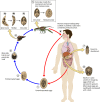Paragonimiasis acquired in the United States: native and nonnative species
- PMID: 23824370
- PMCID: PMC3719489
- DOI: 10.1128/CMR.00103-12
Paragonimiasis acquired in the United States: native and nonnative species
Erratum in
-
Correction for Diaz, Paragonimiasis Acquired in the United States: Native and Nonnative Species.Clin Microbiol Rev. 2015 Oct;28(4):iii. doi: 10.1128/CMR.00064-15. Clin Microbiol Rev. 2015. PMID: 26354825 Free PMC article.
Abstract
Paragonimiasis is a parasitic lung infection caused by lung flukes of the genus Paragonimus, with most cases reported from Asia and caused by P. westermani following consumption of raw or undercooked crustaceans. With the exception of imported P. westermani cases in immigrants, in travelers returning from areas of disease endemicity, and in clusters of acquired cases following consumption of imported Asian crabs, human paragonimiasis caused by native lung flukes is rarely described in the United States, which has only one indigenous species of lung fluke, Paragonimus kellicotti. Clinicians should inquire about the consumption of raw or undercooked freshwater crabs by immigrants, expatriates, and returning travelers, and the consumption of raw or undercooked crayfish in U.S. freshwater river systems where P. kellicotti is endemic when evaluating patients presenting with unexplained fever, cough, rales, hemoptysis, pleural effusions, and peripheral eosinophilia. Diagnostic evaluation by specific parasitological, radiological, serological, and molecular methods will be required in order to differentiate paragonimiasis from tuberculosis, which is not uncommon in recent Asian immigrants. All cases of imported and locally acquired paragonimiasis will require treatment with oral praziquantel to avoid any potential pulmonary and cerebral complications of paragonimiasis, some of which may require surgical interventions.
Figures










References
-
- Blair D, Xu ZB, Agatsuma T. 1999. Paragonimiasis and the genus Paragonimus. Adv. Parasitol. 42:113–222 - PubMed
-
- Lane MA, Barsanti MC, Santos CA, Yeung M, Lubner SJ, Gary J. 2009. Human paragonimiasis in North America following ingestion of raw crayfish. Clin. Infect. Dis. 49:e55–e61 - PubMed
-
- Muller R. 1996. Liver and lung flukes, p 274–285 In Cox FEG. (ed), The Wellcome Trust illustrated history of tropical diseases. The Wellcome Trust, London, United Kingdom
-
- Manson P. 1881. Distoma ringeri. Med. Times Gaz. 2:8–9
Publication types
MeSH terms
LinkOut - more resources
Full Text Sources
Other Literature Sources

